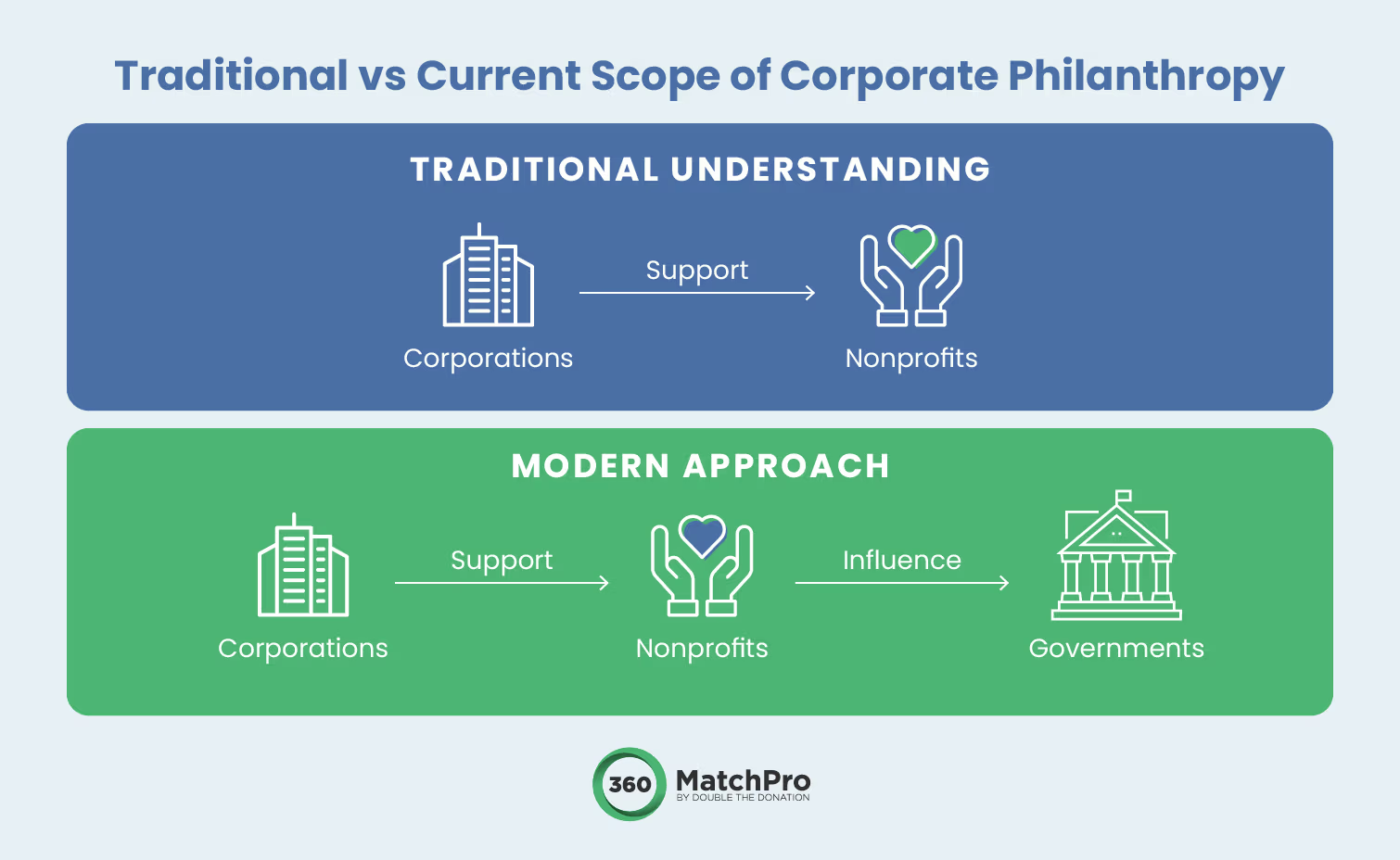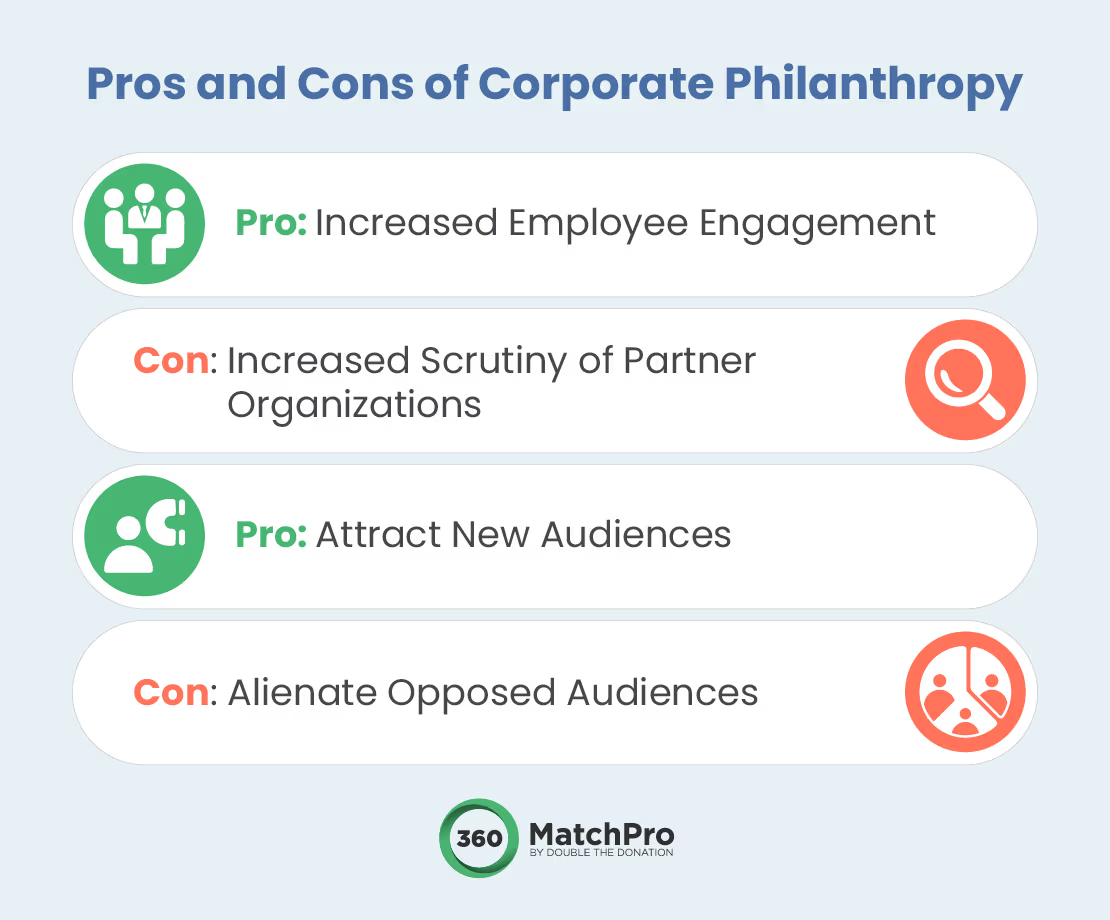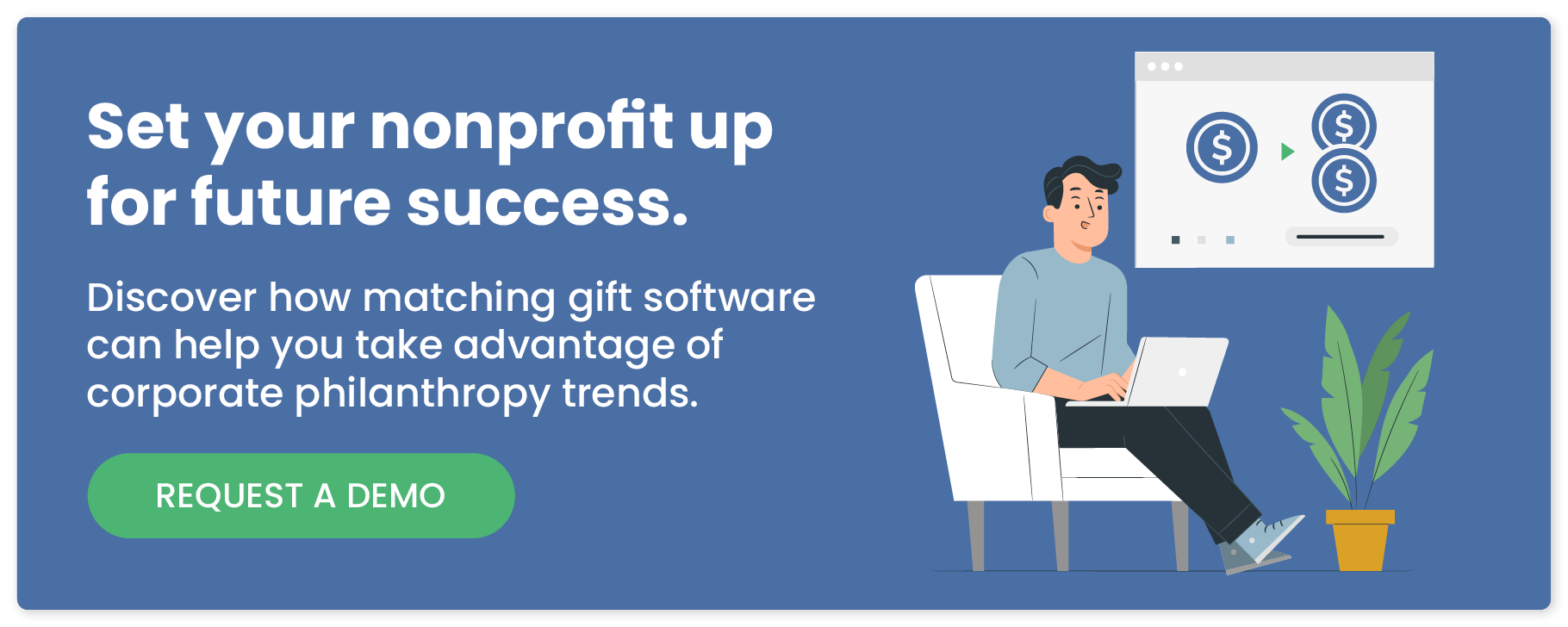5 Trends in Corporate Philanthropy That Dictate the Future
The state of philanthropy is often difficult to measure. For instance, nonprofits in 2023 saw a 20-30% decline in donations on average. However, the amount given to nonprofits on GivingTuesday was up from the previous year, totaling $3.1 billion.
With mixed signals like these, it can be difficult to know if changes in your nonprofit’s donations are reflective of sector-wide changes or just specific to your organization. Fortunately, there is one area of philanthropy that’s highly reported on constantly: corporate giving.
Corporate philanthropy has a long history with the development of the social contract between businesses and consumers gaining traction in the 1970s, but original proponents of the idea date back to the late 1800s with Andrew Carnegie’s Gospel of Wealth.
All this is to say that corporate philanthropy has been around for a long time and has come a long way since its origins. Keeping up with today’s trends can help your nonprofit tap into the support you need. As such, we’re here to explore five trends in corporate philanthropy that will likely dictate the future of the nonprofit sector.
But first, let’s answer a few questions nonprofit leaders who don’t normally follow corporate giving news may have.
Corporate Philanthropy FAQ
What is corporate philanthropy?
Corporate philanthropy includes charitable actions companies take to improve society, usually in the form of donations to charities. Corporations donate to different causes based on their specific philanthropic missions. For instance, one corporation may be dedicated to sustainability while another focuses on improving economic inequality.
Corporate philanthropy is born out of the idea that businesses have responsibilities to society, just as any other citizen does. However, the decision to participate in corporate philanthropy is often a strategic one for businesses. After all, consumers and employees alike are more inclined to engage with businesses that have positive reputations.
One key thing to note is the difference between corporate philanthropy and corporate social responsibility (CSR).

Corporate philanthropy is a type of CSR, but CSR includes additional activities corporations can take to improve society that do not involve donating to nonprofits, such as improving working conditions and ensuring their products are environmentally friendly.
As such, this guide will specifically look at businesses’ practices for giving to nonprofit causes.
Will these trends last?
In general, the world of corporate philanthropy has two speeds: very slow and very fast.
The systems businesses establish to conduct corporate philanthropy are often entrenched and have shaped how the for-profit world interacts with nonprofits for decades. Charitable giving policies get updated but rarely see complete overhauls, and the leaders who oversee corporate philanthropy efforts are usually there for the long haul.
In contrast, major world events, such as the COVID-19 pandemic and mass protests in the summer of 2020, can quickly cause businesses to re-evaluate the causes they’re giving to and why. Other changes, such as evolution in technology and political shake-ups can have similar impacts.
While we can’t guarantee these trends will prevail for decades to come, examples from the business world point to their importance in the current moment. This means whether your nonprofit tries to jump on these trends or not, they likely are impacting your relationships with corporate sponsors in at least some capacity.
What do these trends mean for my nonprofit?
How much corporate giving impacts your nonprofit depends on how much you rely on corporate partnerships, grants, and donations.
If you only seek sponsors for a single annual event each year, you may see a slight uptick or downtick in corporate participation but otherwise not be that greatly impacted. On the other hand, nonprofits that work with several businesses or have plans to improve their networking in the corporate world need to carefully watch these developments.
However, trends in corporate philanthropy generally affect which businesses are interested in working with your nonprofit, how many want to work with your nonprofit, what level of support they will provide, and through what means they’ll support you.
1. Shift in focus areas
Every business has its own philanthropic mission that dictates whether they have a primary focus on supporting the arts, environment, health services, economic development, or any other cause. However, businesses also want to respond to the issues their employees and customers currently care about the most.
Based on the past few years and new emerging philanthropic initiatives, we can make educated guesses about what focus areas businesses will have their eyes on for the foreseeable future. The top three to be aware of are:
- Diversity, equity, and inclusivity (DEI). DEI has been gaining traction as a focus area for years now, and businesses have responded to public demand to take a stronger stance on reporting marginalized groups. This includes internal practices, such as Patagonia’s commitment to becoming an antiracist company and Adobe’s pledge to donate $6 million to support creators from underrepresented groups.
- Environment protection and sustainability. For younger generations, the environment is the issue they feel corporations should be focused on, with one in three Millennials and one in three Gen Zers citing climate change as their top personal concern. Consumers are also increasingly asking companies to expand their efforts and are highly critical of greenwashing.
- Disaster relief. Closely entwined with environmental protections, businesses have also shifted focus to disaster relief. Many local corporations have the ability to act more agilely than governments can in the event of a disaster. This assistance can range toward providing supplies for individuals displaced during natural disasters or pledging to alleviate long-term outcomes of previous disasters.
Nonprofits with these and related focus areas should be loud and proud about their commitments to these pressing issues. However, charitable organizations with other types of missions shouldn’t despair. Instead, continue to do your research and find businesses with philanthropic missions that align with yours.
2. Repositioning what “corporate philanthropy” means and its scope
Businesses are being challenged to do more, and subsequently, leaders in corporate philanthropy are questioning just what “more” means. Let’s take a look at what corporate philanthropy meant just a few years ago compared to what consumers are pushing for today:

- Traditional viewpoint. Businesses engaged in corporate philanthropy should act as external benefactors to nonpartisan charities. Essentially, the business’s role is to provide funding to deserving nonprofits without influencing their operations.
- Current viewpoint. Businesses have a responsibility to be proactive in the causes they champion. This means not only funding nonprofits but also grassroots groups committed to political change. In other words, businesses need to advocate for systemic change by not only supporting good causes but also actively calling out and disengaging with bad practices.
Deloitte’s extensive report on current trends in corporate philanthropy, What’s Next for the Philanthropy in the 2020s: Seeing Philanthropy in a New Light, effectively sums up this phenomenon and provides examples of corporate foundations adjusting their thinking:
Established institutions of all sizes, from the Ford Foundation to the Whitman Institute, are rethinking their strategies, looking for ways to share power and make their giving more “proximate” to the communities they serve. Funders from Los Angeles to Montreal are experimenting with political action—advocating for policy change that can guide the allocation of large pools of government dollars. And popular books like Winners Take All, Just Giving, and Decolonizing Wealth, along with recent critiques and legislation focused on donor-advised funds, have called out harmful power dynamics and posed serious and existential questions about the practices and structures of philanthropy.
For your nonprofit, look for businesses interested in taking a more active role in being a partner to your organization. This might take the form of marketing support, providing access to additional resources and networks, or helping your nonprofit develop new programs.
3. Increased focus on local and community groups
Ultimately, businesses are outsiders in the nonprofit world. Corporate philanthropy experts today understand that local businesses are the experts on the issues that impact their communities and are the ones with the knowledge and infrastructure to make an impact.
What this means in practice is that some businesses are turning away from establishing their own nonprofits or philanthropic practices and instead relying more on supporting external nonprofits. As part of this shift in attitudes, more corporations are considering the role of grantmaking. Through grantmaking, businesses can put their mission statement out into the world and, with a little promotion, trust that nonprofits will flock to them rather than needing to seek them out.
As a nonprofit, this means reconsidering your grant application strategy by asking questions, such as:
- Do we have the research tools we need to find new grant opportunities?
- Is our nonprofit equipped to put together a strong grant proposal?
- Do we have relationships with businesses and foundation leaders we can leverage to get our foot in the door?
Additionally, when it comes to grants, many businesses are embracing a trust-based approach to nonprofits they already have relationships with. This means that in times of crisis, the business will wave various normal stipulations, or even the entire grant application process, to provide immediate funding.
All of this means that just like with your donors, your nonprofit’s strongest tool for tapping into corporate philanthropy is the relationships you can build with business leaders. Consider how you can show off your work and knowledge of your community to businesses. This might involve seeking an initial small-scale sponsorship or partnering with an organization to host a corporate volunteer day.
4. Incorporation of technology
How businesses deliver support to nonprofits is dependent on the technology they have at their disposal. Software solutions like workplace giving platforms have enabled corporations to organize their employee giving programs and even provide their teams with information on reputable nonprofits to support.
However, looking forward, the name of the game is automation. The faster, more convenient, and less resource and time-intensive it is to participate in philanthropy, the more businesses will do so. This applies to individual donors and corporations alike.
For instance, one tool changing a popular corporate giving program, matching gifts, is matching gift auto-submission. Auto-submission transfers potentially lengthy matching gift application processes by giving donors the option to have their match requests completed for them.
Here’s how it works:

- Donor gives like normal to a nonprofit with matching gift software. Auto-submission is currently only available to donors who give to nonprofits with 360MatchPro. This is because auto-submission is possible through Double the Donation’s partnerships with select CSR software vendors. Essentially, auto-submission technology pulls information from the CSR software and 360MatchPro, meaning both are necessary to access this tool.
- The donor enters their corporate email address. To connect eligible donors with their employer’s CSR platform, supporters are asked to provide their corporate email address while giving. With this information, the software automatically pulls up their information.
- The donor is given the option to use auto-submission. After completing their gift, donors are given the choice to opt-in to auto-submission. If they choose to, their matching gift application will be submitted for them with no additional work needed on their part.
For a more in-depth look at how this software works, check out this video from our team at Double the Donation:
5. Association of identity and philanthropy
Philanthropy is no longer just something a company does. Rather, it’s a reflection of the company’s beliefs and values. Consumers and employees then want to associate with brands they feel share their values.
As such, businesses need to be conscious of their consumer base’s values when making philanthropic decisions. This is especially important for businesses with a younger audience. For instance, according to employee engagement surveys, 75% of millennials would take a pay cut to work for an employer they see as socially responsible.
This leads to opportunities and hurdles alike for nonprofits, such as:

- Pro: Businesses can use philanthropy to engage employees. If a corporation can find a cause a majority of its employees feel strongly about, they can boost their engagement and increase loyalty by supporting it.
- Con: If a nonprofit fails to produce results or behaves poorly, the business’s reputation may be damaged. This goes both ways, meaning nonprofits and businesses alike need to do their due diligence in vetting potential partner organizations.
- Pro: Individuals who feel strongly about a cause are likely to seek out businesses that explicitly support it. This can help businesses earn new customers and potentially get your nonprofit in front of people who haven’t heard of your organization but want to buy from a brand that supports causes like yours.
- Con: Businesses are increasingly wary of partnering with nonprofit causes seen as partisan. For example, some companies have recently started the practice of “green hushing” wherein they downplay their positive environmental impact due to recent backlash over ESG and fears of being accused of greenwashing if their efforts fall short.
For nonprofits, frankly assess your cause and who your audience is. Then, seek out businesses that have audiences who likely already support your mission. Through these partnerships, your nonprofit will gain access to new potential donors who are predisposed to consider supporting you, and the business will be able to maintain a clear and consistent brand image without fear of potential backlash.
More Corporate Philanthropy Resources
Corporate philanthropy evolves just as attitudes, business practices, and CSR technology shift over time. Stay up to date with the latest developments by reading philanthropy journals, keeping up with the news, and connecting with other nonprofit professionals.
To discover even more about the current state of corporate philanthropy, check out these additional resources:
- What Is Dollars for Doers? Everything You Need to Know. An underutilized type of corporate philanthropy is volunteer grants, also known as dollars for doers. Explore how your nonprofit can take advantage of this corporate giving program.
- How to Market Matching Gifts: The Comprehensive FAQ Guide. Matching gifts are a key part of corporate philanthropy, and your nonprofit can earn more by promoting them to supporters. Get tips on how to market them in this guide!
- 8 Trends in Corporate Philanthropy for 2024: How to Tap In. Discover even more trends in philanthropy and how your nonprofit can take advantage of them.






